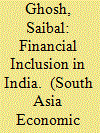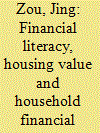|
|
|
Sort Order |
|
|
|
Items / Page
|
|
|
|
|
|
|
| Srl | Item |
| 1 |
ID:
107325


|
|
|
|
|
| Publication |
2011.
|
| Summary/Abstract |
This study sought to investigate the impact of firm and non-firm characteristics on crime incidence in South Africa using a Probit model and 2007 data from World Bank enterprise surveys. Results show that the firm characteristics in the country that increase the likelihood of being subjected to crime is the size of the firm, ownership structure (foreign or locally owned), and market orientation. Small firms appear to be more vulnerable to criminal attack, probably because they lack resources to invest in quality security systems. The study also found that firms that are foreign owned and are involved in export experience less incidence of crime compared to others. This can be partly attributed to the fact that most of these outward-oriented or foreign-owned firms are relatively large in size and are thus able to spend more on security systems that are effective in detecting and deterring crime. There is therefore a need for government, together with the business community, to come up with affordable but effective security measures to assist small establishments, locally owned and inward-oriented firms to detect and combat crime. This would lead to greater industrial growth, investment promotion and employment creation.
|
|
|
|
|
|
|
|
|
|
|
|
|
|
|
|
| 2 |
ID:
175349


|
|
|
|
|
| Summary/Abstract |
Employing a novel district-level survey data for India, the study investigates the impact of distance on financial inclusion. Using advanced econometric techniques, the findings indicate that distance primarily dampens the use of bank accounts as compared with access. These results are robust irrespective of whether distance is measured in terms of the time taken to reach the banking infrastructure or physical distance. These results are robust to a wide battery of robustness checks. The analysis suggests the need for policy strategies that can address the tyranny of distance towards achieving the financial inclusion goal.
|
|
|
|
|
|
|
|
|
|
|
|
|
|
|
|
| 3 |
ID:
168343


|
|
|
|
|
| Summary/Abstract |
Using data from the 2012 consumer finance survey in China, we extend the literature on household finance by examining the effects of both financial literacy and housing value on household financial market participation, the role of which has been examined separately in the existing literature. The results show that financial literacy significantly improves the probability of household financial market participation, while the housing value has an obvious “crowding-out effect” on household financial market participation in urban China. Further research finds that the role of financial literacy in household financial market participation in households with a low housing value is stronger than that in households with a high housing value. Furthermore, the study of the regional differences shows that among households with a high housing value, financial literacy plays a more significant role in household bond market participation in less-developed cities. Among households with a low housing value, improvement in financial literacy plays a more significant role in household fund market participation in less-developed cities and under-developed cities. Our findings remain robust after alleviating potential bias due to endogenous problems by applying the instrumental variable (IV) method and propensity score matching (PSM) method. Finally, the paper proposes corresponding policy recommendations.
|
|
|
|
|
|
|
|
|
|
|
|
|
|
|
|
| 4 |
ID:
175250


|
|
|
|
|
| Summary/Abstract |
Solar energy is one of the most valuable renewable sources of energy for the socioeconomic development of a nation. Despite Myanmar has abundant solar energy resources, there are some obstacles that hinder the development of solar energy in Myanmar. To this end, this study uses contingent valuation method to estimate the public willingness-to-pay for solar energy research and development in Myanmar. Based on the survey of 550 respondents, this study indicates that, on average, Myanmar residents are willing to pay an additional 1500 kyat ($1) per month per household for research and development of Myanmar's solar energy. The total annual willingness-to-pay for the research and development of solar energy in Myanmar is estimated at 198 billion kyat ($132 million). Respondents' education level, monthly household income, knowledge of energy issues, degree of concern about energy issues, and awareness of the benefits of solar energy influence their willingness-to-pay decisions, while bid prices have a significant negative impact on their willingness-to-pay decisions. In addition to these factors, this study estimates willingness-to-pays for different geographic locations in Myanmar. This study provides Myanmar authorities with useful and important insights to develop more effective renewable energy policies for solar energy development across the country.
|
|
|
|
|
|
|
|
|
|
|
|
|
|
|
|
| 5 |
ID:
129830


|
|
|
|
|
| Publication |
2014.
|
| Summary/Abstract |
We investigate whether differences in terrorism risk are mirrored on terrorism risk perception across European countries for the period 2003-2007. We find that the average propensity for terrorism risk concern is affected by actual risk levels. Country and individual heterogeneity contribute substantially to the variation of observed risk perception. Singles and individuals with white collar jobs are less likely to mention terrorism as one of the most pressing issues their country faces, while political positioning towards the right makes it more likely to be concerned about terrorism. As far as competing risks are concerned, we find that the likelihood terrorism is mentioned, decreases with spending on pensions as a percentage of GDP being higher. Finally, based on the Bayesian framework, we also examined the formation of terrorism risk perceptions, and decompose the observed country-level time series of terrorism activity into a long- and a short-run component. We concluded that the observed risk perception variation is only explained by the long-term trend of terrorism activity countries face.
|
|
|
|
|
|
|
|
|
|
|
|
|
|
|
|
|
|
|
|
|